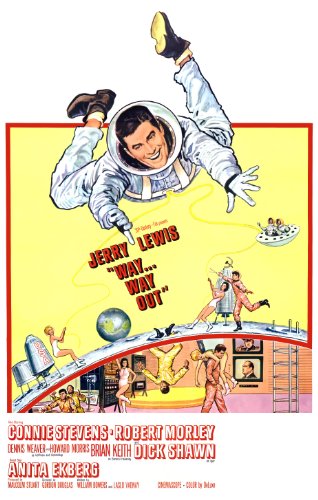Way … Way Out
Way … Way Out (1966) starring Jerry Lewis, Connie Stevens, Dick Shawn, Anita Ekberg
Synopsis of Way… Way Out
Way … Way Out is set in the “far future” of 1986 (!), there’s a problem with the American lunar base — the men stationed there for long-term missions are going stir-crazy from lack of … female companionship. The American government decides to solve the problem by sending up a married American team in their place — but the only astronaut qualified is Pete Mattemore (Jerry Lewis), who is still single.
Way … Way OutThe Big Mouth
The Big Mouth (1967) starring Jerry Lewis, Del Moore, Charlie Callas
Synopsis of The Big Mouth, starring Jerry Lewis
In The Big Mouth, Jerry Lewis plays the role of Gerald Clamson. He’s a bank examiner on vacation who, while fishing, catches a frogman. The frogman, who coincidentally is the spitting image of Jerry Lewis, has stolen diamonds from his criminal gang, and hidden them at a nearby resort hotel.Clamson takes the map to the diamonds given him by the frogman, and makes his escape while the gangsters attack. At the hotel, Jerry Lewis accidentally injures the hotel manager, played by Del Moore. So Jerry Lewis disguises himself as the title character from The Nutty Professor in order to investigate the mystery at the hotel. At this point, there are three different subplots running together:
The Big MouthThe Bellboy
The Bellboy(1960), starring Jerry Lewis
Don’t Raise the Bridge, Lower the River
Don’t Raise the Bridge, Lower the River (1968) starring Jerry Lewis, Jacqueline Pearce, Terry-Thomas
Don’t Raise the Bridge, Lower the River is a Jerry Lewis film, based on the book of the same name. Oddly, Jerry Lewis is cast playing the part of the straight man in the movie. He plays George Lester, an American who goes from one get-rich-quick scheme to another. Much to the distress of his suffering wife Pamela, played by the lovely Jacqueline Pearce. After three years of being dragged across the globe, she has had enough of his constant neglect of her. And she sues for divorce. While she leaves the country as part of dealing with her emotions, George decides to ‘renovate’ her ancestral home. It’s a stately English manor, that he turns into a 1960’s style discotheque and Chinese restaurant. When Pamela eventually returns home, she is aghast. And George thought to regain her affections by proving that he can make money by staying in England.
Don’t Raise the Bridge, Lower the RiverHook, Line and Sinker [Jerry Lewis]
Hook, Line and Sinker (1969) starring Jerry Lewis, Anne Francis, Peter Lawford
Synopsis of Hook, Line and Sinker
In Hook, Line and Sinker, Jerry Lewis plays the part of Peter Ingersoll. He’s an unhappy insurance salesman who’s living the American Dream. Only to be so caught up in the rat race that he’s unable to enjoy any part of his life. His normal existence is interrupted, however, when his doctor (played by Peter Lawford) and best friend diagnoses him with a weak heart, and gives him the news that he only has a few months to live.
Hook, Line and Sinker [Jerry Lewis]Three on a Couch
Three on a Couch (1966) starring Jerry Lewis, Janet Leigh, James Best
Three on a Couch is a Jerry Lewis comedy that’s both funny and charming. The basic plot is that Jerry Lewis’ character, Christopher Pride, is an artist who has won a prestigious French art contest, winning a large monetary prize, as well as the opportunity to live in Paris, France for a year. He intends to take his fiancee, Dr. Elizabeth Acord (played by Janet Leigh) along so that they can be married. But there’s a problem.
Three on a CouchThe Nutty Professor
The Nutty Professor (1963) starring Jerry Lewis, Stella Stevens
I Married a Witch
I Married a Witch (1942) starring Fredric March, Veronica Lake, Susan Hayward, Cecil Kellaway
Modern Times
Summary of Modern Times, (1936), starring Charlie Chaplin, Paulette Goddard
Modern Times begins with Charlie Chaplin as Charlie the Little Tramp gainfully employed at a factory. However, the strict regimentation is driving him to the brink … Then over the brink, when the factory owner has him as the “guinea pig” for a “time-saving” feeding machine. This leads to Charlie spending time in a mental hospital. Cured after his breakdown. But then he is arrested and jailed when …. He innocently picks up a red flag that has fallen off the back of a truck and runs down the street to return it …. Just when a communist demonstration comes around the corner. He meets Paulette Goddard as ‘The Gamin’ (a street urchin) in the back of the police van. She is arrested for stealing bread. From then on the theme is about the two trying to get along in … modern times
Modern Times